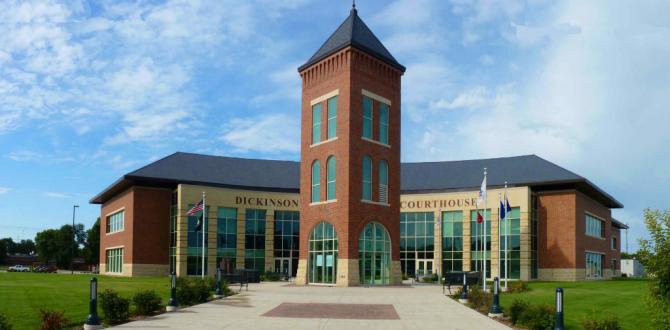Since the founding of our communities, organizations, businesses and citizens have stepped forward to build and serve their community. Click on any of the logos below to learn about those who made this website possible! If you would like to learn about becoming a sponsor CLICK HERE!
Dickinson County, IA
County in Northern IADickinson County, the smallest Iowa county in land area, is named in honor of Daniel S. Dickinson, a lawyer and senator from New York.
In the summer of 1856 Rowland Gardner came from Cerro Gordo County to settle. He and his family erected cabins, which came to be known as Gardners Grove. Soon after many families started to settle in the area. But by the end of the year the population was only 40 residents, half of that being children.
In the winter of 1856-1857 a renegade band of Sioux Indians attacked the settlers around the lake, killing all but four women. Later, two of the four women were murdered and the remaining two were rescued. For six days the ravaging and pillaging of settlements and killing of livestock continued. Word of the “Spirit Lake Massacre” finally reached Fort Dodge. An expedition was launched to pursue the Indians, but the main job turned out to be burying the dead.
Following the massacre there was a large increase in settlers, especially in the summer. This second wave of pioneers organized the county for independence. A petition was sent to the judge in Woodbury County, a seven-day journey by horseback, asking for a separate organization. An election was held calling for county officials, and on August 4, 1857 Dickinson County was formed.
The first courthouse was built in Spirit Lake. It was begun in 1859 and partially finished in 1860. In 1860 it was used as a barracks for Civil War troops and was completed in 1868. This building was destroyed by fire in 1872.
A second courthouse was constructed using the salvageable bricks of the first courthouse, but it was soon deemed unsatisfactory and condemned in 1880.
In September 1889 a $15,000 bond issue was proposed for the construction of a new courthouse. It was passed by a large majority. Construction of the third courthouse began on October 4, 1890 and was completed in 1891. Since its completion the building has seen three additions, one in 1957 and two more in 1976 and 1978. The funding for these additions came from the Federal Revenue Sharing fund.
Taken from “History of County Governments in Iowa”, published in 1992 by the Iowa State Association of Counties, Des Moines, Iowa

- County: Dickinson County, IA
- Region: Northern IA
Destination Dickinson County, IA
- Sponsors
- Towns
- Businesses
- Community Organizations
- Faith Organizations
- Festivals and Events
- Points of Interest
- Veterans
Learn how to contribute to any of the above categories.
Towns of Dickinson County, IA
The small towns of the Midwest are rich in history and a great way of life! Below you can visit and learn about the small towns we call home! Towns that have their name highlighted have become FEATURED TOWNS. Businesses/organizations from these towns have stepped forward as SPONSORS enabling us to include (or will include as acquired) stories and website links to ALL their community organizations (chambers, groups and departments, etc.), stories and website links to ALL their points of interest, annual festivals/events and stories done about their citizens, veterans and faith community. To learn how to become a featured town CLICK HERE!
Businesses of Dickinson County, IA
The businesses of our towns are truly the lifeblood of each community, click on any businesses below to learn about them, to learn how to add your business to your town and county page CLICK HERE!
Community Organizations of Dickinson County, IA
Small towns and rural communities throughout the Midwest are looking for ways to strengthen their economies, provide better quality of life, and build on local assets. Here you will find the organizations that stabilize, preserve, and revitalize the small towns and rural areas alike. To submit your organization to be included on your town and county page CLICK HERE!
Events of Dickinson County, IA
The small towns of the Midwest have long shared pride in their communities through festivals and events! Citizens from each community, working together, continue to offer entertainment options that not only appeal to their citizens, but visitors to their community! Below you will find festivals and events you are sure to want to attend! If you would like to have (DST) include an annual festival or event on your town and county page CLICK HERE!
Faith Organizations of Dickinson County, IA
Throughout the years faith organizations have not only been an essential part of a town's religious life, but its community life. Below you will find stories about these organizations, If you would like to induct a faith organization to be added to your town and county page CLICK HERE!
Points of Interest of Dickinson County, IA
The communities of the Midwest have a lifestyle unique to their region — rich in history and points of interest like no other! Below you will find points of interest you are sure to want to visit! To nominate a landmark, historic location, museum, etc. as a point of interest on your county and region page CLICK HERE!
Veterans of Dickinson County, IA
Veterans come from many walks of life and whether a veteran has severed two decades ago or two days ago, they have made our freedoms possible. Below you will find stories about many who have served. If you would like to nominate a veteran to be included on your town and county page CLICK HERE!









































































































































